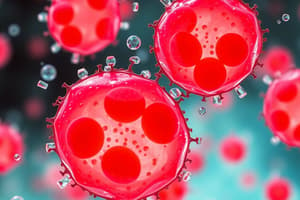Podcast
Questions and Answers
What is a defining feature of prokaryotic cells?
What is a defining feature of prokaryotic cells?
- They lack membrane-bound organelles. (correct)
- They are generally larger than eukaryotes.
- They contain multiple chromosomes.
- They have a nucleus.
Which structure is common to both prokaryotic and eukaryotic cells?
Which structure is common to both prokaryotic and eukaryotic cells?
- Mitochondria
- Nucleus
- Cell wall
- Ribosomes (correct)
What type of genetic material do both prokaryotic and eukaryotic cells contain?
What type of genetic material do both prokaryotic and eukaryotic cells contain?
- Protein
- RNA
- DNA (correct)
- RNA and DNA
Which of the following statements about eukaryotic cells is TRUE?
Which of the following statements about eukaryotic cells is TRUE?
What structure functions to protect the cell and regulate what enters and exits?
What structure functions to protect the cell and regulate what enters and exits?
Which characteristic is unique to plant eukaryotic cells compared to animal eukaryotic cells?
Which characteristic is unique to plant eukaryotic cells compared to animal eukaryotic cells?
What is the primary component of the prokaryotic cell wall?
What is the primary component of the prokaryotic cell wall?
Which of the following statements about cytoplasm is accurate?
Which of the following statements about cytoplasm is accurate?
What is the average size range of prokaryotic cells?
What is the average size range of prokaryotic cells?
Which of the following is a characteristic unique to eukaryotic cells?
Which of the following is a characteristic unique to eukaryotic cells?
What type of reproduction do prokaryotic cells primarily undergo?
What type of reproduction do prokaryotic cells primarily undergo?
Which ribosome size is found in eukaryotic cells?
Which ribosome size is found in eukaryotic cells?
What feature differentiates the DNA structure of prokaryotic and eukaryotic cells?
What feature differentiates the DNA structure of prokaryotic and eukaryotic cells?
Which type of cell division is characteristic of eukaryotic cells?
Which type of cell division is characteristic of eukaryotic cells?
Which of the following organelles is found only in eukaryotic cells?
Which of the following organelles is found only in eukaryotic cells?
Flashcards are hidden until you start studying
Study Notes
Prokaryotes vs. Eukaryotes: Similarities
- Both cell types possess a cell membrane (plasma membrane) – a phospholipid bilayer regulating substance entry and exit.
- Both contain DNA as their genetic material, a double helix determining cellular growth, function, and reproduction.
- Both have ribosomes, composed of ribonucleotides and protein, responsible for protein synthesis from mRNA, although the ribosomal structures differ.
- Both contain cytoplasm – a thick fluid providing cell shape and a site for metabolic reactions.
Prokaryotes vs. Eukaryotes: Differences
- Cell Size: Prokaryotes (0.1-5 µm) are significantly smaller and simpler than eukaryotes (10-100 µm, some much larger).
- Cell Arrangement: Prokaryotes are typically unicellular, sometimes forming biofilms (clusters cooperating through quorum sensing), while eukaryotes can be unicellular or multicellular.
- Nucleus: Eukaryotes possess a membrane-bound nucleus protecting DNA, crucial for gene regulation, unlike prokaryotes with a nucleoid region lacking a membrane.
- Membrane-Bound Organelles: Only eukaryotes have membrane-enclosed organelles (endoplasmic reticulum, Golgi apparatus, lysosomes, mitochondria, chloroplasts, peroxisomes, vesicles, plastids, vacuoles) compartmentalizing cellular functions.
- DNA Structure: Prokaryotes have a single circular chromosome with operons (gene clusters), lacking post-transcriptional processing; eukaryotes have multiple linear chromosomes, lacking operons, with separate transcription and translation and post-transcriptional processing. Prokaryotes may also have plasmids (smaller circular DNA).
- Ribosome Size: Prokaryotes have smaller 70S ribosomes (50S and 30S subunits), while eukaryotes have larger 80S ribosomes (60S and 40S subunits).
- Cytoskeleton: Both have cytoskeletons, but with different protein compositions: eukaryotes use actin, intermediate filaments, and microtubules; prokaryotes use FtsZ, MreB/Mbl, and others.
- Reproduction: Prokaryotes reproduce asexually via binary fission; eukaryotes reproduce sexually, forming gametes.
- Cell Division: Prokaryotes use binary fission; eukaryotes employ mitosis for more complex chromosome distribution during cell division.
Studying That Suits You
Use AI to generate personalized quizzes and flashcards to suit your learning preferences.




